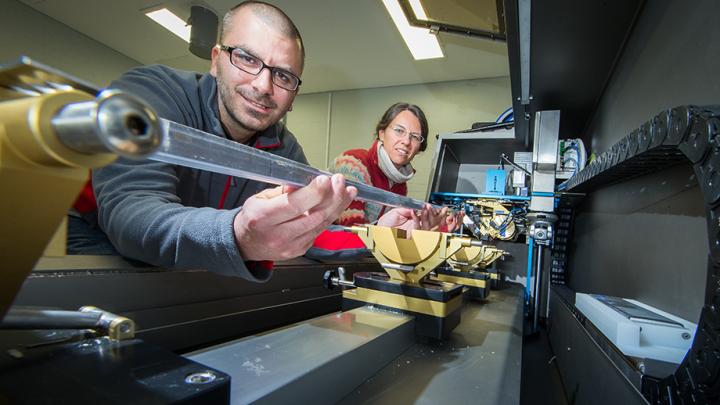Ice sheet collapse triggered ancient sea level peak: ANU media release

Dr. Gianluca Marino and Dr. Katharine Grant load a sediment core into an X-ray fluorescence scanner. Credit: Stuart Hay, ANU
An international team of scientists has found a dramatic ice sheet collapse at the end of the ice age before last caused widespread climate changes and led to a peak in the sea level well above its present height.
The team found the events 135,000 years ago caused the planet to warm in a different way to the end of the most recent ice age about 20,000 to 10,000 years ago.
The findings will help scientists understand the processes that control Earth's dramatic climate changes, said the leader of the study, Dr Gianluca Marino of The Australian National University (ANU).
“We knew the sea level had overshot its present levels during the last interglacial period, but did not know why. Now we for the first time can explain the processes that caused the sea levels to exceed the present levels,” said Dr Marino, from the ANU Research School of Earth Sciences.
“Ice-age cycles may superficially look similar to one another, but there are important differences in the relationships between melting of continental ice sheets and global climate changes.”
The team, which includes researchers from ANU as well as the Universities of Southampton and Swansea in the UK, has published their findings in Nature.
At the end of an ice age the continental ice sheets, ocean, and atmosphere change rapidly. Scientists have previously only been able to reconstruct in detail the changes at the end of the last ice age.
“We have compared the fluctuations at the end of an earlier ice age, and we found that the patterns were different,” said co-author Professor Eelco Rohling, from both ANU and the University of Southampton.
“At the end of the older ice age, 135,000 years ago, we found that a dramatic collapse of the Northern Hemisphere ice sheets into the North Atlantic Ocean suppressed the ocean circulation and caused cooling in the North Atlantic.”
“North Atlantic cooling was counterbalanced by Southern Ocean warming that then destabilised Antarctic land ice, causing a continuation of melting that eventually drove sea level rise to several meters above the present,” he said.
This is very different from the end of the last ice age, said Dr Marino.
“The northern hemisphere ice-sheet collapse and climate change did not occur at the same time, and that caused much less warming in Antarctica,” he said.
The team used precisely-dated cave records and marine sediments from the Mediterranean region to reconstruct the sequence of changes in all critical climate parameters.
Media Contact
All latest news from the category: Earth Sciences
Earth Sciences (also referred to as Geosciences), which deals with basic issues surrounding our planet, plays a vital role in the area of energy and raw materials supply.
Earth Sciences comprises subjects such as geology, geography, geological informatics, paleontology, mineralogy, petrography, crystallography, geophysics, geodesy, glaciology, cartography, photogrammetry, meteorology and seismology, early-warning systems, earthquake research and polar research.
Newest articles

First-of-its-kind study uses remote sensing to monitor plastic debris in rivers and lakes
Remote sensing creates a cost-effective solution to monitoring plastic pollution. A first-of-its-kind study from researchers at the University of Minnesota Twin Cities shows how remote sensing can help monitor and…

Laser-based artificial neuron mimics nerve cell functions at lightning speed
With a processing speed a billion times faster than nature, chip-based laser neuron could help advance AI tasks such as pattern recognition and sequence prediction. Researchers have developed a laser-based…

Optimising the processing of plastic waste
Just one look in the yellow bin reveals a colourful jumble of different types of plastic. However, the purer and more uniform plastic waste is, the easier it is to…



